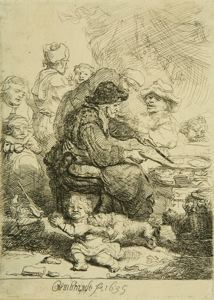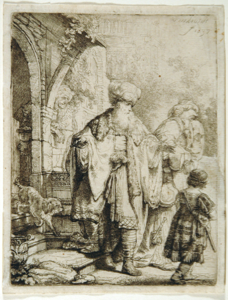
Rembrandt van Rijn
Dutch, 1606–1669
In European society children were not considered separately as a “class” until the seventeenth century. Prior to that time, societies did not consider children as individuals but as members of the larger society who had yet to mature. There were many reasons for these attitudes; however, the primary one was most likely the probability of early death for many born before the eighteenth century. Rembrandt was one of the few early masters who chose to depict the characteristic behaviors of children in his works. This image of an old woman selling pancakes on the street contains the rather humorous image of a young boy whose possession of a hard-won pancake is being threatened by a hungry dog.
Dutch, 1606–1669
The Pancake Woman
1635
Object Type:
Print
Creation Place:
Northern Europe, Dutch
Dimensions:
4 3/8 in. x 3 3/16 in. (11.11 cm x 8.1 cm)
Medium and Support:
Etching on laid paper
Accession Number:
1999.0007.0072
Credit Line:
Gift of Jean K. Weil in memory of Adolph "Bucks" Weil, Jr.
In European society children were not considered separately as a “class” until the seventeenth century. Prior to that time, societies did not consider children as individuals but as members of the larger society who had yet to mature. There were many reasons for these attitudes; however, the primary one was most likely the probability of early death for many born before the eighteenth century. Rembrandt was one of the few early masters who chose to depict the characteristic behaviors of children in his works. This image of an old woman selling pancakes on the street contains the rather humorous image of a young boy whose possession of a hard-won pancake is being threatened by a hungry dog.
Keywords
Click a term to view the records with the same keyword
Portfolio List
Click a portfolio name to view all the objects in that portfolio
This object is a member of the following portfolios:
Your current search criteria is: Keyword is "BG" and [Object]Century is "Seventeenth Century".

